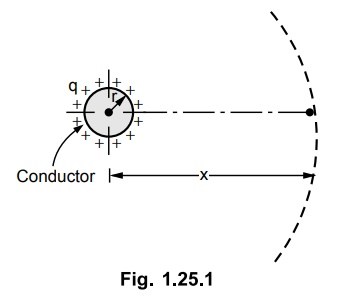Transmission and Distribution: Unit I: Transmission Line Parameters
Electric Potential at Single Charged Conductor
The electric potential at a point due to a charge is measured by the work done in bringing unit positive charge from infinity to that point.
Electric Potential at
Single Charged Conductor
The electric potential at a point due to
a charge is measured by the work done in bringing unit positive charge from
infinity to that point. This electric potential is measured in volts and plays
important role in determining capacitance in a circuit which is defined as
charge (q) per unit potential (V).
Consider a long straight cylindrical
conductor placed in uniform medium such as air as shown in the Fig. 1.25.1.

It carries a charge along its entire
length given by + q coulombs per meter. The electric flux lines of this charged
conductor are radial and uniformly placed. The points which are equally placed
from this conductor are at same potential and have the same flux density (D).
Let us obtain electric flux density at a
distance x from the conductor i.e. along cylindrical surface of radius x
meters.
The electric flux density on the surface
is equal to the flux leaving the conductor per meter of length divided by the
surface area in an axial length of 1 m with radius x meters.

If D is divided by the permittivity of
the medium (e) the we get electric field intensity (E).

As x approaches ∞, the value of E
approaches zero. Thus the potential difference between conductor and neutral
plane at infinity distance where E and potential is zero, is given by,

Review Question
1. Explain electric potential at single charged conductor.
Transmission and Distribution: Unit I: Transmission Line Parameters : Tag: : - Electric Potential at Single Charged Conductor
Related Topics
Related Subjects
Transmission and Distribution
EE3401 TD 4th Semester EEE Dept | 2021 Regulation | 4th Semester EEE Dept 2021 Regulation
